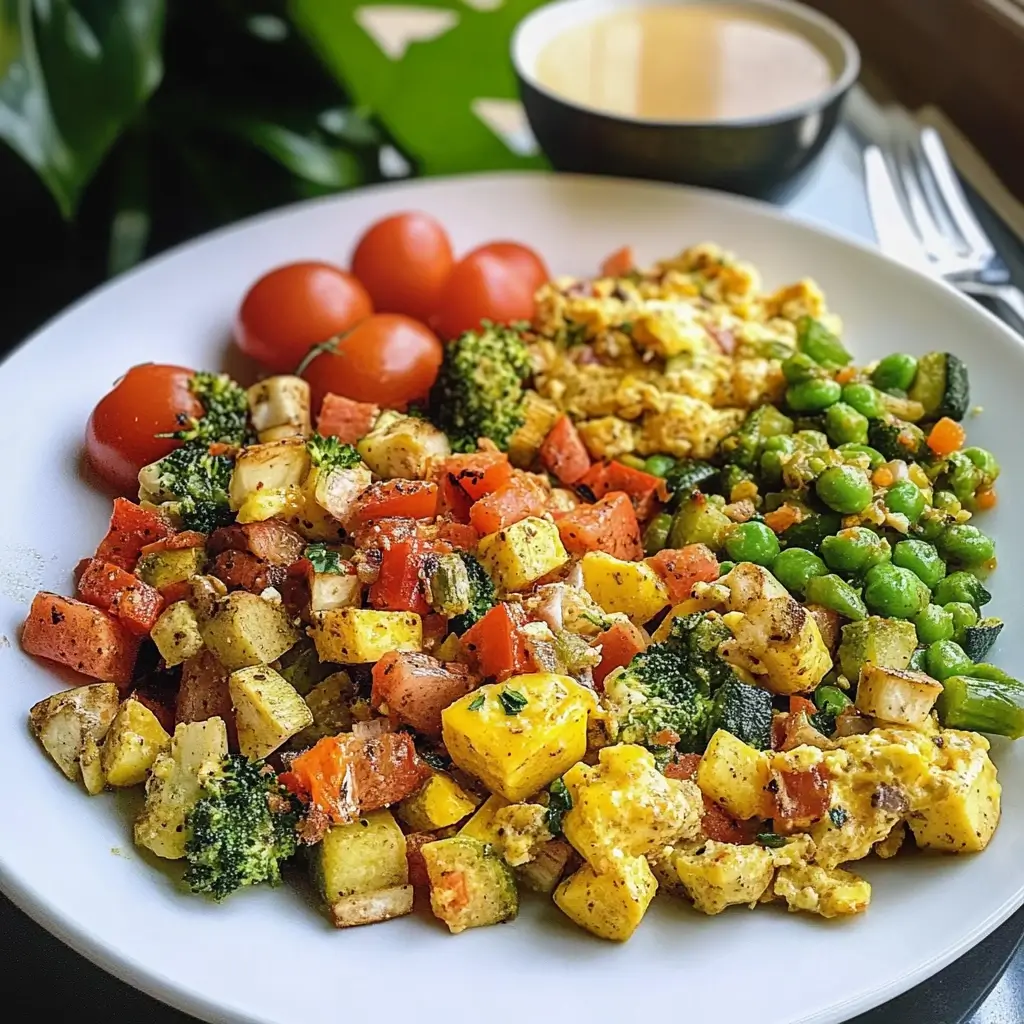It was one of those chaotic weekday mornings – the kind where everyone’s rushing, a school project is overdue, and the thought of making a nutritious breakfast feels like climbing Mount Everest. I needed something quick, healthy, and universally appealing to a family with varying (and sometimes picky!) tastes. That’s when the Vegetable Breakfast Scramble truly became our hero. I’d always made scrambled eggs, of course, but this version, packed with colorful veggies, transformed a simple dish into a vibrant, energizing meal. The kids, surprisingly, loved picking out their favorite vegetables (once they were sautéed to sweet perfection), and my husband appreciated the protein punch to start his long day. It’s become such a staple that “scramble morning” is now met with cheers, not groans. It’s more than just a recipe; it’s a solution – a delicious, adaptable, and stress-free way to ensure my family gets a fantastic start to their day. Plus, it’s a brilliant way to use up those leftover bits of vegetables from the crisper drawer, making it a win for our health, our taste buds, and our efforts to reduce food waste!
The Ultimate Vegetable Breakfast Scramble: Your Go-To Healthy Start
Breakfast is often touted as the most important meal of the day, and for good reason. It breaks the overnight fast, replenishes your supply of glucose to boost your energy levels and alertness, and provides other essential nutrients required for good health. But let’s be honest, finding the time and inspiration for a healthy, satisfying breakfast can be a challenge, especially on busy mornings. That’s where the humble yet mighty Vegetable Breakfast Scramble shines.
This isn’t just any scramble; it’s a powerhouse of flavor, nutrition, and versatility. It’s quick to prepare, infinitely customizable, and a fantastic way to sneak in a good portion of your daily vegetable intake before you’ve even properly started your day. Forget sugary cereals or bland toast; this scramble will leave you feeling energized, satisfied, and ready to tackle whatever comes your way. It’s perfect for individuals, couples, or the whole family, and adapts beautifully to various dietary preferences.
Why This Vegetable Breakfast Scramble is a Winner
Before we dive into the delicious details, let’s explore why this recipe deserves a permanent spot in your breakfast rotation:
- Nutritional Powerhouse: Eggs are a fantastic source of high-quality protein, essential amino acids, vitamins D and B12, and choline (important for brain health). Combine them with a colorful array of vegetables, and you’re adding fiber, vitamins (A, C, K), minerals (potassium, magnesium), and antioxidants. This combination supports muscle health, boosts immunity, aids digestion, and provides sustained energy.
- Infinitely Customizable: This is perhaps the biggest draw. Don’t like bell peppers? Swap them for zucchini. Have some leftover mushrooms? Toss them in! Spinach, kale, asparagus, broccoli, onions, tomatoes – the possibilities are endless. You can also play with herbs, spices, and cheeses to create a new flavor profile every time.
- Quick and Easy: From chopping board to plate, this scramble can be ready in under 20-25 minutes, making it ideal for busy weekday mornings. Even if you’re not a morning person, this recipe is straightforward enough to manage pre-coffee.
- Reduces Food Waste: Have a few lonely vegetables lingering in your fridge? A breakfast scramble is the perfect way to use them up before they go bad, making it an economical and environmentally conscious choice.
- Family-Friendly: Even picky eaters can often be tempted by a colorful scramble, especially if they get to choose some of the vegetable additions. The mild flavor of the eggs provides a good base for various veggie tastes.
- Great for Meal Prep: While best enjoyed fresh, you can certainly chop your vegetables in advance to save time in the morning. Some components, like sautéed onions and peppers, can even be made ahead and stored.
- Diet-Friendly: This recipe is naturally gluten-free and can easily be made dairy-free (omit cheese or use a dairy-free alternative). It fits well into low-carb, keto (with mindful veggie choices), and vegetarian lifestyles.
Now, let’s get to crafting this delightful dish!
Ingredients: The Building Blocks of Flavor and Nutrition
The beauty of this recipe lies in its flexibility, but here’s a fantastic base to get you started. Feel free to adjust quantities based on how many you’re serving and your personal preferences. This recipe serves 2-3 generously.
- Eggs: 6 large, preferably free-range or organic for the best flavor and nutritional profile.
- Cooking Fat: 1 tablespoon olive oil or unsalted butter (or a mix). Avocado oil is also a great choice.
- Aromatics:
- 1/2 medium yellow onion, finely chopped (about 1/2 cup)
- 2 cloves garlic, minced
- Hearty Vegetables:
- 1/2 medium red bell pepper, deseeded and diced
- 1/2 medium green bell pepper, deseeded and diced (or use any color combination you like!)
- 1 cup cremini or white button mushrooms, sliced or quartered
- Leafy Greens: 2 cups fresh spinach, roughly chopped (it wilts down significantly!)
- Finishing Touches (Optional but Recommended):
- 1/2 cup cherry or grape tomatoes, halved (add these towards the end to prevent sogginess)
- 1/4 cup shredded cheese (cheddar, Monterey Jack, feta, or Gruyère work well)
- 2 tablespoons milk, half-and-half, or unsweetened almond milk (for creamier eggs, optional)
- Seasoning:
- 1/2 teaspoon sea salt (or to taste)
- 1/4 teaspoon black pepper (or to taste)
- Pinch of red pepper flakes (optional, for a little heat)
- Fresh herbs for garnish (e.g., chives, parsley, cilantro), finely chopped
Ingredient Notes & Potential Substitutions:
- Eggs: The quality of your eggs makes a difference. Pasture-raised eggs often have richer yolks and more nutrients.
- Vegetables: This is where you can get creative!
- Other great additions: Diced zucchini or yellow squash, chopped broccoli florets (blanch or microwave briefly first if large), asparagus tips, kale (remove tough stems and chop), corn kernels (fresh or frozen), peas.
- For a Southwestern twist: Add black beans (rinsed and drained), corn, and use jalapeño instead of red pepper flakes. Garnish with cilantro and serve with salsa.
- For a Mediterranean vibe: Use feta cheese, sun-dried tomatoes (oil-packed, drained), Kalamata olives, and oregano.
- Cheese: If dairy-free, you can omit the cheese or use a dairy-free shredded cheese alternative. Nutritional yeast can also add a cheesy, umami flavor.
- Herbs & Spices: Don’t be afraid to experiment. Smoked paprika, cumin, dried oregano, or a pinch of turmeric (for color and anti-inflammatory benefits) can all add wonderful depth.
- Milk/Cream: Adding a little liquid to your eggs before whisking can result in a slightly fluffier, more tender scramble. However, some purists prefer eggs alone. It’s up to you!
Instructions: Crafting the Perfect Vegetable Scramble
Follow these steps for a delicious and perfectly cooked vegetable breakfast scramble every time. The key is to cook the vegetables properly before adding the eggs.
- Prepare Your Ingredients (Mise en Place):
- Wash and chop all your vegetables as indicated. Mince the garlic.
- In a medium bowl, crack the eggs. Add the optional milk/cream, salt, and pepper. Whisk thoroughly until the yolks and whites are fully combined and the mixture is slightly frothy. Set aside.
- If using cheese, have it shredded and ready.
- Sauté the Aromatics and Heartier Vegetables:
- Heat the olive oil or butter in a large non-stick skillet or well-seasoned cast-iron pan over medium heat.
- Once the oil is shimmering (or butter is melted and foamy), add the chopped onion. Sauté for 3-4 minutes, stirring occasionally, until softened and translucent.
- Add the diced bell peppers and sliced mushrooms to the skillet. Continue to cook for another 5-7 minutes, stirring occasionally, until the peppers are tender-crisp and the mushrooms have released their liquid and started to brown. This step is crucial for developing flavor.
- Stir in the minced garlic and optional red pepper flakes. Cook for another minute until fragrant. Be careful not to burn the garlic.
- Wilt the Greens:
- Add the chopped spinach (and/or kale, if using) to the skillet. It will look like a lot, but it wilts down quickly. Stir gently for 1-2 minutes until the spinach is just wilted.
- Cook the Eggs:
- Give the whisked egg mixture one last stir. Pour it evenly over the vegetables in the skillet.
- Let the eggs set for about 30-60 seconds without stirring. This helps create larger, fluffier curds.
- Using a spatula, gently push the cooked egg from the edges towards the center, tilting the pan so the uncooked egg flows underneath. Continue this process, gently folding and scrambling, until the eggs are mostly set but still slightly moist. Avoid over-stirring, which can make the eggs tough and watery.
- Add Finishing Touches:
- If using, sprinkle the shredded cheese and halved cherry tomatoes over the scramble.
- Gently fold them in and cook for another 30 seconds to a minute, just until the cheese is melted and the tomatoes are slightly warmed.
- Be careful not to overcook at this stage; you want the eggs to be creamy, not dry.
- Serve Immediately:
- Remove the skillet from the heat. Taste and adjust seasoning if necessary (more salt, pepper, or a dash of hot sauce).
- Garnish with fresh chopped herbs like chives or parsley. Serve hot and enjoy your vibrant, nutritious breakfast!
Nutrition Facts
- Servings: This recipe makes 2-3 hearty servings.
- Calories per serving (approximate for 2 servings, will vary based on specific ingredients and cheese): Approximately 350-450 calories.
A More Detailed Look at the Nutritional Benefits:
- Protein-Packed: Eggs are a complete protein source, providing all nine essential amino acids. Protein is crucial for building and repairing tissues, supporting immune function, and promoting satiety, which helps keep you full and satisfied until your next meal.
- Rich in Vitamins:
- Vitamin D: Found in egg yolks, essential for bone health and immune function.
- Vitamin B12: Crucial for nerve function and the formation of red blood cells.
- Vitamin A: Bell peppers and spinach are excellent sources, important for vision, immune function, and skin health.
- Vitamin C: Abundant in bell peppers and tomatoes, a powerful antioxidant that supports the immune system.
- Vitamin K: Spinach is a fantastic source, vital for blood clotting and bone health.
- Folate: Found in spinach and eggs, important for cell division and DNA synthesis.
- Mineral-Rich:
- Iron: Spinach and eggs provide iron, essential for carrying oxygen in the blood.
- Potassium: Mushrooms, spinach, and tomatoes are good sources, helping to regulate blood pressure.
- Magnesium: Found in leafy greens and nuts (if you add them), involved in hundreds of biochemical reactions in the body.
- Healthy Fats: If using olive oil, you’re getting monounsaturated fats, which are heart-healthy. Eggs also contain healthy fats, including omega-3 fatty acids (especially in pasture-raised eggs).
- Fiber: The vegetables contribute dietary fiber, which aids digestion, helps regulate blood sugar levels, and promotes a feeling of fullness.
- Antioxidants: The colorful array of vegetables provides a wide range of antioxidants, which help protect your cells from damage caused by free radicals.
Disclaimer: The nutritional information provided is an estimate and can vary significantly based on the exact ingredients, quantities, and brands used. For precise nutritional data, it’s recommended to use a dedicated nutrition calculator with your specific ingredients.
Preparation Time
- Preparation (Chopping Vegetables, Whisking Eggs): 10-15 minutes
- Cooking Time: 10-12 minutes
- Total Time: Approximately 20-27 minutes
This quick turnaround makes it a genuinely feasible option even when you’re short on time. To speed things up even more, consider chopping your vegetables the night before and storing them in an airtight container in the refrigerator.
How to Serve Your Vegetable Breakfast Scramble
While delicious on its own, here are some fantastic ways to serve and enhance your vegetable breakfast scramble:
- Classic Comfort:
- Serve with a slice of whole-grain toast (buttered or plain) for dipping.
- Add a side of crispy bacon or sausage (turkey or chicken sausage for a leaner option).
- Fresh & Light:
- Top with sliced avocado for extra creaminess and healthy fats.
- Serve alongside a small bowl of fresh fruit (berries, melon, or citrus) for a complete and balanced meal.
- Flavor Boosters:
- Drizzle with your favorite hot sauce (Sriracha, Tabasco, Cholula) for a spicy kick.
- Add a dollop of salsa or pico de gallo for freshness and zest.
- A spoonful of guacamole on the side or on top is always a winner.
- A sprinkle of “Everything Bagel” seasoning can add a delightful crunch and flavor.
- Heartier Options:
- Use the scramble as a filling for breakfast burritos or tacos using whole-wheat or corn tortillas.
- Serve over a bed of sautéed sweet potatoes or roasted potatoes for a more substantial meal.
- Spoon into a baked potato or sweet potato for a unique twist.
- Global Inspirations:
- Mexican-Inspired: Top with cotija cheese, cilantro, lime wedges, and pickled jalapeños.
- Greek-Inspired: Use feta cheese, Kalamata olives, sun-dried tomatoes, and fresh dill or oregano. Serve with a side of pita bread.
- Low-Carb/Keto Friendly:
- Serve in lettuce cups (butter lettuce or romaine) instead of toast or tortillas.
- Pair with a side of sliced tomatoes and cucumbers dressed with olive oil and herbs.
The presentation also matters! Serving it in a colorful bowl or on a bright plate can make the meal even more appealing. Don’t forget that fresh herb garnish – it adds a pop of color and freshness.
Additional Tips for Scramble Success
Elevate your vegetable breakfast scramble from good to great with these pro tips:
- Don’t Overcrowd the Pan: When sautéing vegetables, ensure they have enough space in the pan. Overcrowding will cause them to steam rather than brown, resulting in less flavor development and a soggier texture. If necessary, cook vegetables in batches.
- Low and Slow for Creamier Eggs (Optional): While this recipe uses medium heat for efficiency, if you have a little extra time and prefer ultra-creamy, custard-like eggs, try cooking the eggs over low heat, stirring gently and frequently. This prevents them from drying out.
- Fresh Herbs Make a Difference: While dried herbs can be used in a pinch (add them with the garlic), fresh herbs added at the end provide unparalleled brightness and flavor. Chives, parsley, cilantro, dill, or even a touch of basil can transform your scramble.
- Prep Ahead for Super-Speedy Mornings: As mentioned, you can chop all your non-juicy vegetables (onions, peppers, mushrooms) a day or two in advance. Store them in an airtight container in the fridge. You can even whisk your eggs with seasoning and store them covered in the fridge overnight. This cuts down morning prep to just a few minutes.
- Seasoning is Key – And Season in Layers: Don’t just rely on salt and pepper added with the eggs. Consider lightly seasoning your vegetables as they cook. This helps build layers of flavor. Taste the final scramble and adjust seasoning before serving. A little salt can make all the other flavors pop.
FAQ Section: Your Vegetable Scramble Questions Answered
Here are some common questions you might have about making the perfect vegetable breakfast scramble:
- Q: Can I make this recipe vegan?
- A: Absolutely! Instead of eggs, you can make a delicious Tofu Scramble. Crumble firm or extra-firm tofu into the pan after sautéing the vegetables. Season it with nutritional yeast (for a cheesy flavor), turmeric (for color), black salt (kala namak, for an “eggy” flavor if desired), garlic powder, onion powder, salt, and pepper. Cook until heated through and slightly browned.
- Q: How do I store and reheat leftover vegetable scramble?
- A: Store leftovers in an airtight container in the refrigerator for up to 2-3 days. To reheat, gently warm in a non-stick skillet over low heat, stirring occasionally, until heated through. You can add a splash of water or milk if it seems dry. Alternatively, microwave in short 30-second intervals, stirring in between, until warm. Be careful not to overheat, as eggs can become rubbery.
- Q: Can I use frozen vegetables in this scramble?
- A: Yes, you can use frozen vegetables, but it requires a slight adjustment. It’s best to thaw and drain them thoroughly before adding to the pan to avoid excess moisture making your scramble watery. Alternatively, you can add them directly from frozen to the hot pan (after the onions), but be prepared for them to release more water; cook until this excess liquid has evaporated before adding the eggs. Frozen spinach works particularly well – just be sure to squeeze out all excess water after thawing.
- Q: What are some other vegetables that work well in a breakfast scramble?
- A: The sky’s the limit! Some other excellent choices include:
- Asparagus: Snap off the woody ends and chop into 1-inch pieces.
- Zucchini or Yellow Squash: Dice them; they cook quickly.
- Broccoli or Cauliflower Florets: Chop them small and consider pre-steaming or microwaving them briefly to ensure they’re tender.
- Leeks: Use the white and light green parts, sliced and well-rinsed. They offer a milder onion flavor.
- Sweet Potatoes: Dice small and roast or pan-fry until tender before adding to the scramble.
- Peas: Fresh or frozen work well.
- A: The sky’s the limit! Some other excellent choices include:
- Q: How do I prevent my vegetable scramble from becoming soggy or watery?
- A: Several things can help:
- Cook down high-moisture vegetables: Mushrooms and spinach release a lot of water. Make sure to cook them until this moisture has mostly evaporated before adding the eggs.
- Add watery vegetables last: Tomatoes, for example, should be added towards the very end of cooking, just to warm through. Cooking them too long will make them release too much liquid.
- Don’t overcrowd the pan: This causes steaming instead of sautéing.
- Avoid over-stirring the eggs: Gentle folding is better.
- Don’t overcook the eggs: Cook until just set but still slightly moist. They will continue to cook a bit from residual heat.
- A: Several things can help:
This Vegetable Breakfast Scramble is more than just a meal; it’s a canvas for your culinary creativity and a commitment to starting your day on a healthy, delicious note. It’s a testament to the fact that nutritious food can be quick, easy, and incredibly satisfying. So, raid your refrigerator, get chopping, and enjoy a breakfast that will fuel your body and delight your taste buds. We hope this becomes a beloved staple in your household, just as it has in ours! Enjoy every vibrant, flavorful bite.
Print
Vegetable Breakfast Scrambles Recipe
Ingredients
- Eggs: 6 large, preferably free-range or organic for the best flavor and nutritional profile.
- Cooking Fat: 1 tablespoon olive oil or unsalted butter (or a mix). Avocado oil is also a great choice.
- Aromatics:
- 1/2 medium yellow onion, finely chopped (about 1/2 cup)
- 2 cloves garlic, minced
- Hearty Vegetables:
- 1/2 medium red bell pepper, deseeded and diced
- 1/2 medium green bell pepper, deseeded and diced (or use any color combination you like!)
- 1 cup cremini or white button mushrooms, sliced or quartered
- Leafy Greens: 2 cups fresh spinach, roughly chopped (it wilts down significantly!)
- Finishing Touches (Optional but Recommended):
- 1/2 cup cherry or grape tomatoes, halved (add these towards the end to prevent sogginess)
- 1/4 cup shredded cheese (cheddar, Monterey Jack, feta, or Gruyère work well)
- 2 tablespoons milk, half-and-half, or unsweetened almond milk (for creamier eggs, optional)
- Seasoning:
- 1/2 teaspoon sea salt (or to taste)
- 1/4 teaspoon black pepper (or to taste)
- Pinch of red pepper flakes (optional, for a little heat)
- Fresh herbs for garnish (e.g., chives, parsley, cilantro), finely chopped
Instructions
- Prepare Your Ingredients (Mise en Place):
- Wash and chop all your vegetables as indicated. Mince the garlic.
- In a medium bowl, crack the eggs. Add the optional milk/cream, salt, and pepper. Whisk thoroughly until the yolks and whites are fully combined and the mixture is slightly frothy. Set aside.
- If using cheese, have it shredded and ready.
- Sauté the Aromatics and Heartier Vegetables:
- Heat the olive oil or butter in a large non-stick skillet or well-seasoned cast-iron pan over medium heat.
- Once the oil is shimmering (or butter is melted and foamy), add the chopped onion. Sauté for 3-4 minutes, stirring occasionally, until softened and translucent.
- Add the diced bell peppers and sliced mushrooms to the skillet. Continue to cook for another 5-7 minutes, stirring occasionally, until the peppers are tender-crisp and the mushrooms have released their liquid and started to brown. This step is crucial for developing flavor.
- Stir in the minced garlic and optional red pepper flakes. Cook for another minute until fragrant. Be careful not to burn the garlic.
- Wilt the Greens:
- Add the chopped spinach (and/or kale, if using) to the skillet. It will look like a lot, but it wilts down quickly. Stir gently for 1-2 minutes until the spinach is just wilted.
- Cook the Eggs:
- Give the whisked egg mixture one last stir. Pour it evenly over the vegetables in the skillet.
- Let the eggs set for about 30-60 seconds without stirring. This helps create larger, fluffier curds.
- Using a spatula, gently push the cooked egg from the edges towards the center, tilting the pan so the uncooked egg flows underneath. Continue this process, gently folding and scrambling, until the eggs are mostly set but still slightly moist. Avoid over-stirring, which can make the eggs tough and watery.
- Add Finishing Touches:
- If using, sprinkle the shredded cheese and halved cherry tomatoes over the scramble.
- Gently fold them in and cook for another 30 seconds to a minute, just until the cheese is melted and the tomatoes are slightly warmed.
- Be careful not to overcook at this stage; you want the eggs to be creamy, not dry.
- Serve Immediately:
- Remove the skillet from the heat. Taste and adjust seasoning if necessary (more salt, pepper, or a dash of hot sauce).
- Garnish with fresh chopped herbs like chives or parsley. Serve hot and enjoy your vibrant, nutritious breakfast!
Nutrition
- Serving Size: One Normal Portion
- Calories: 350-450





